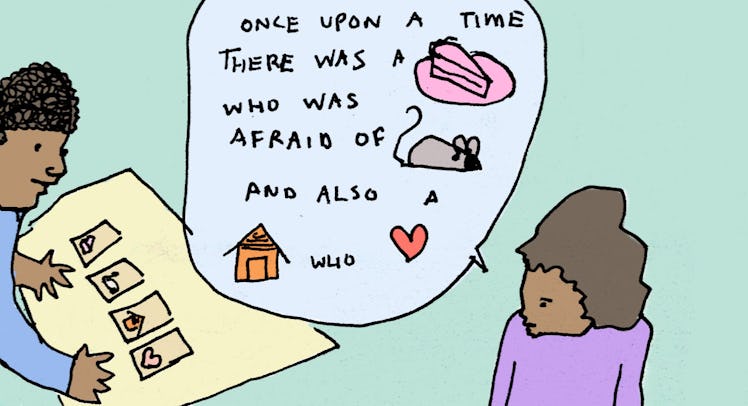‘Story Cards’ Help Kids Spin the Silliest Bedtime Tales
Plus, it takes the pressure off you to always come up with an engaging yarn.

Story Cards is part arts-and-crafts activity, part imagination game. It involves making a deck of homemade picture cards ⏤ personalized for your kid(s) with drawings of familiar objects, favorite words, inside jokes, or even photographs of relatives, pets, or friends ⏤ and then drawing those cards one at a time to tell a fun story. Making the cards is a creative bonding activity while the storytelling game ⏤ which is different every time you play ⏤ helps stir young imaginations. Plus, it takes the pressure off you to always spin an engaging yarn. Story Cards is a great way to unwind and is one of the activities for kids that’s ideal for pre-nap or bedtime routines.
Prep Time: About an hour to draw and ‘laminate’ the cards. Once the deck is made, however, there is no prep time.
Entertainment Time: Depending on the size of the deck, up to an hour.Energy Expended by Child: Moderate mental energy.
What You Need:
- 8.5″ x 11″ paper, and lots of it. Cardstock is better but pricier.
- Crayons, markers, or colored pencils, scissors, and glue (optional)
- A roll of wide packing tape.
- A list (or pictures) of 50 or more objects, people, places, animals, etc. Again, these can be tailored to the kid(s) to make the stories more personal.
How to Play:
First up, make the cards. Cut each sheet of 8.5″ x 11″ paper or cardstock into 10 playing cards (3.5″ x 2.5″) until you have enough cards for the items on your list. Obviously, the more cards you make the longer and/or different the stories can be. Using crayons, markers, or colored pencils, draw a single item on one side of each card. The other side stays blank. If your (or your child’s) drawing skills are suspect, you can also cut out images from magazines or family photographs ⏤ or print them from the internet ⏤ and glue them to the cards. From there, use the packing tape to ‘laminate’ each card. After trimming away the excess tape around the edges, you should have a stack of slick looking playing cards.
Now the fun begins. The game’s rules are simple: Either you or a child pick a card off the top of the shuffled, face-down stack and starts to tell the story. If you select a card with a person, for example, you’d begin with: “Uncle Dave woke up one day and…” Just be sure to leave the action hanging so the next player can continue with whatever’s on the next card. If the first card is a place, you’d kick the tale off with: “A long time ago in Ancient Egypt, there was a…” You get the idea. Each new card adds to the story’s plot and the game continues until you are out of cards. You can also split up the deck to tell shorter stories or chapters.
The stories don’t have to make sense. In fact, it’s a lot more fun when they don’t, as is evidenced by the perplexed expression on your kid’s face when they learn that Mommy just ended up on Jupiter. That said, if you want the stories to be more coherent and less whimsical, you can spread out all the cards face-up on the table and allow players to pick the specific card they believe best moves the story’s action along.
Wrap Up:
The beauty of Story Cards is that, once the deck is made, the game can be spontaneous. You can bring it with you to the doctor’s office or on vacation, and assuming you made enough cards, it doesn’t get old ⏤ you’re building a new story every time. And if it does, just draw up some new cards and open up a whole new world of details and storylines. That way, you can have even more fun telling the tale of Spider-Man’s search for Nemo’s lost … steak in … Hawaii? Good luck.

This article was originally published on